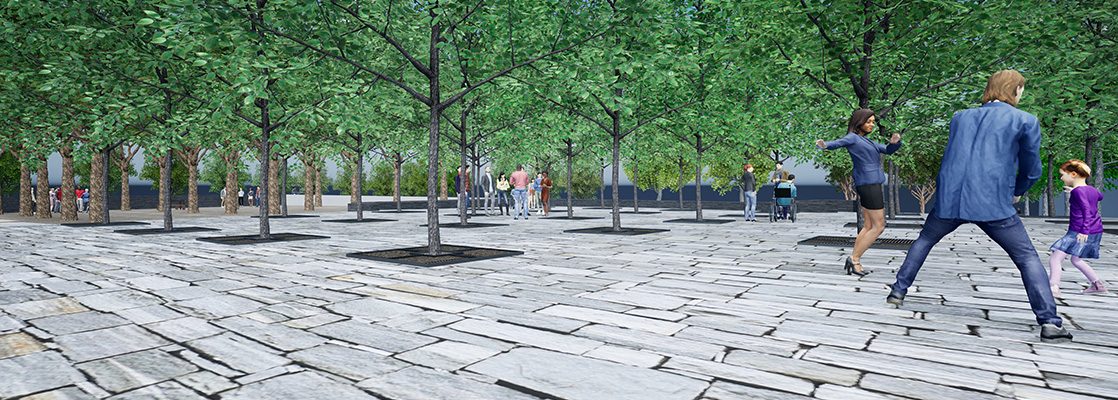Module 3: Pollinator Garden

This module presents another important type of landscape installation: the urban treed plaza in a hardscape context. Trees in the city (or on a large, crowded campus) provide a myriad of services. Appropriately designed, they ameliorate microclimate, providing essential shade and evapo-transpirative cooling during hotter weather. They slow stormwater runoff, enhance infiltration, filter polluted air, fix carbon, and exude fresh oxygen. They help calm traffic and, in sufficient mass, can soften the din of the city. Trees animate the urban environment by providing shelter and food for birds, pollinators, and other creatures. They flower, fruit, and mark the seasons’ passing in locales where live greenery is often in short supply. Native trees, in particular, can harbor pollinator larvae. And, of course, urban trees define and create volumetric space—so important to creating convivial and memorable urban places.
One of this module’s key challenges is promoting tree longevity and health while still accommodating the urban environment’s complex physical and social dynamics. Urban tree longevity is closely tied to the volume of high-quality soil, free exchange of gases available to roots, and adequate (but not excessive) water. As we’ll see, non-permeable paving and compressive forces can result in soil compaction and lack of aeration, which can frustrate these objectives, as can poorly chosen and arranged tree species.
Thus, this module emphasizes the interplay between tree selection, plaza layout, plaza surfacing material, and below-ground root zone arboriculture and technology. There will be a brief sketch concept exercise followed by an intensive period of exploring and developing the technical aspects of a proposed ‘urban’ treed plaza for the Millennium Science Complex. [Please re-read the Goals, Objectives, and Program statement provided earlier in the semester, including the vision that sees this treed plaza serving students, university employees, and visitors.]
Learning Objectives
- Create a well-crafted tree plaza plan and plant schedule (AutoCAD and Excel)
- Gain experience in the horticulture and ‘ecoculture’ of established and emerging planting genres—the mixed pollinator garden, treed urban plaza, meadow and hydric habitats, and other planted landscape contexts;
- Build technical abilities in species selection, planting establishment and soil improvement methods, planting installation details, and adaptive management of the planted landscape
Reference Resources
- Waterline addition plan reference
- Pennsylvania Projected Climate Change
- Pennsylvania Ridge and Valley Trees and Climate Change
- Pennsylvania Climate Change Adaptation Plan
- GreenBlue Soil Volume Guide
- Deeproot Silva Cell 2
- CityGreen’s Stratavault
GreenBlue Urban’s root anchor systems and “nature tie”
- CU-Structural Soil background
CU-Structural Soil suppliers:
- Stabilized Aggregate Paving (be sure to also do your own research)
http://www.stabilizersolutions.com/products/stabilized-decomposed-granite-and-crushed-stone/
Penn State’s “Trail Surface Aggregate”: https://dirtandgravel.psu.edu/wp-content/uploads/2022/03/TSA_tech_bulletin_2014-1.pdf
https://dirtandgravel.psu.edu/wp-content/uploads/2022/03/TSA_Spec_Cert_6-2020-1.pdf
https://www.kafkagranite.com/natural-crushed-stone/pathway-materials/stabilized-pathway-mix/
- Engineered Gravel Paving (be sure to also do your own research)
Engineered Gravel Paving:
Heicom Tree Sand (a UK outfit, but OK to use for our purposes):
StaLite PermaTill Structural Soil:
Utelite Structural Soil:
